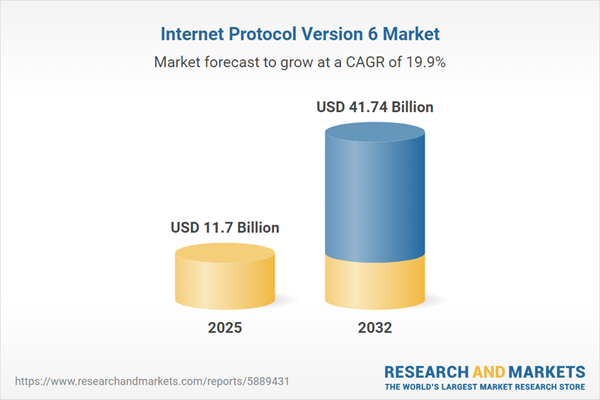Speak directly to the analyst to clarify any post sales queries you may have.
As enterprises face disruptive shifts from digital transformation and evolving regulations, the IPv6 market presents a pivotal path forward for network modernization and resilient IT strategy. Senior decision-makers are tackling rising operational complexity by adopting standards-driven networking to maintain agility, compliance, and secure business continuity in a distributed digital landscape.
Market Snapshot: IPv6 Market Growth and Opportunity
The IPv6 market demonstrates significant growth momentum as organizations future-proof their network infrastructure. In 2024, market size reached USD 9.77 billion, with expansion expected to USD 11.70 billion by 2025 and a projected leap to USD 41.74 billion in 2032—reflecting a CAGR of 19.90%. Enterprise priorities for heightened network security, scalable cloud and edge deployments, and investment in policy-driven technology are accelerating adoption. Digital operations are being enhanced to address regulatory pressures, support remote and hybrid workforces, and enable secure, centralized management for distributed operations. The pace of IPv6 transition is also reinforced by the need to integrate emerging digital assets efficiently across industries.
Scope & Segmentation Overview
- Core Infrastructure Elements: Routers, gateways, servers, and switches are complemented by consulting, implementation services, and ongoing maintenance that together enable scalable and reliable IPv6-driven performance for enterprises upgrading their network backbones.
- Software Platforms: Threat protection, network automation, and solutions supporting interoperability are critical for integrating IPv6 into legacy and next-generation environments, ensuring business operations remain efficient and future-ready.
- Deployment Models: Dual stack, native IPv6, and tunneling solutions, including 6to4, ISATAP, and Teredo, allow phased or full-scale transitions to IPv6 according to an organization’s readiness, with minimal impact on ongoing operations.
- Industry Verticals: Financial services, public agencies, healthcare, IT and telecommunications, and retail are driving IPv6 uptake to enhance compliance, cybersecurity, and modernization amid evolving regulatory and operational needs.
- Applications: Data center optimization, virtualization, improved mobile connectivity, secure VPN-based remote access, and IoT integration contribute to maintaining business continuity and supporting growth objectives.
- Organization Size: IPv6 solutions scale to suit both large enterprises and SMBs, enabling gradual network transformation in line with varying IT maturity levels and operational needs.
- Regions: Adoption is shaped by unique regulatory standards, investment priorities, and government initiatives across the Americas, Europe, Middle East and Africa, and Asia-Pacific, influencing how enterprises prioritize their infrastructure upgrades and compliance strategies.
- Leading Companies: Cisco Systems, Huawei Technologies, Hewlett Packard Enterprise, Nokia, Juniper Networks, Arista Networks, Ciena Corporation, Dell Technologies, ZTE Corporation, and H3C Technologies lead through R&D, partnerships, and commitment to evolving the global IPv6 ecosystem.
Key Takeaways for Senior Decision-Makers
- Strategic IPv6 migration empowers organizations to manage complex digital infrastructures, integrating next-generation technologies and aligning with shifting business environments for greater efficiency.
- Migrating to IPv6 strengthens policy compliance and supports risk mitigation, providing a structured approach within highly regulated industries.
- Automation and advanced network management features in IPv6 architectures streamline day-to-day IT activities, allowing teams to focus on long-term business initiatives.
- Flexible migration options, such as dual stack and tunneling, ensure digital modernization continues without disrupting operations or jeopardizing productivity.
- Understanding diverse regional compliance frameworks and organizational maturity levels enables decision-makers to plan targeted IPv6 implementation programs and anticipate evolving policy demands.
- Collaboration via standards organizations fosters improved interoperability, reducing risks in multi-vendor and rapidly changing network landscapes.
Tariff Impact: United States Trade Policies Shaping IPv6 Market Dynamics
Current United States trade policies are altering procurement strategies in the IPv6 hardware space. Enterprises are reassessing supply chain approaches by diversifying sources and emphasizing domestic network investments. As regulations evolve, these changes strengthen organizational resilience and align modernization efforts with compliance-driven priorities for sustained performance.
Methodology & Data Sources
This report utilizes a triangulated methodology, including one-on-one executive interviews, targeted technology adoption surveys, and comprehensive secondary research. All findings are peer-validated, ensuring actionable insights for strategic network transformation.
Why This Report Matters: IPv6 Market Outcomes for Technology Leaders
- Guides senior leaders through each stage of IPv6 migration, ensuring that evaluation, planning, and operational integration support seamless, risk-managed transitions.
- Clarifies the influence of sectoral, regulatory, and regional dynamics for informed network modernization that bolsters organizational strategy and competitiveness.
- Provides practical recommendations for building secure, flexible networks aligned to emerging regulations and evolving business requirements.
Conclusion
This report enables senior decision-makers to align IPv6 strategies with core business goals, supporting secure, resilient, and compliant network operations as digital transformation evolves.
Additional Product Information:
- Purchase of this report includes 1 year online access with quarterly updates.
- This report can be updated on request. Please contact our Customer Experience team using the Ask a Question widget on our website.
Table of Contents
3. Executive Summary
4. Market Overview
7. Cumulative Impact of Artificial Intelligence 2025
Companies Mentioned
The companies profiled in this Internet Protocol Version 6 market report include:- Cisco Systems, Inc.
- Huawei Technologies Co., Ltd.
- Hewlett Packard Enterprise Company
- Nokia Corporation
- Juniper Networks, Inc.
- Arista Networks, Inc.
- Ciena Corporation
- Dell Technologies Inc.
- ZTE Corporation
- H3C Technologies Co., Ltd.
Table Information
| Report Attribute | Details |
|---|---|
| No. of Pages | 193 |
| Published | November 2025 |
| Forecast Period | 2025 - 2032 |
| Estimated Market Value ( USD | $ 11.7 Billion |
| Forecasted Market Value ( USD | $ 41.74 Billion |
| Compound Annual Growth Rate | 19.9% |
| Regions Covered | Global |
| No. of Companies Mentioned | 11 |









